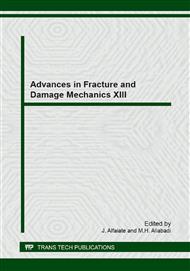p.409
p.413
p.417
p.421
p.425
p.429
p.433
p.437
p.441
An Experimental Evaluation for Four Multiaxial Fatigue Approaches
Abstract:
A series of tests for low cycle fatigue were conducted on the tubular specimens for 304 stainless steel under variable amplitude and irregular axial-torsional loading. Rainflow cycle counting and linear damage rule are used to calculate fatigue damage and four approaches, e.g. SWT(Smith-Watson-Topper), KBM(Kandil-Brown-Miller), FS(Fatemi-Socie), and LKN(Lee-Kim-Nam) approach are employed to predict the fatigue life. The maximum shear strain plane, the maximum normal strain plane, and the maximum damage plane are considered as the critical plane, respectively. The effects of the choice of the critical plane on previous approaches are discussed. It is shown that comparing with the maximum shear/normal strain approach, the predictions are improved by using the maximum damage plane approach, part nonproportional paths for SWT, AV and part nonproportional paths for KBM, TV paths for FS. But for LKN, the prediction results are nonconservative for some paths than that of the maximum shear/normal strain approach.
Info:
Periodical:
Pages:
425-428
Citation:
Online since:
September 2014
Authors:
Price:
Сopyright:
© 2015 Trans Tech Publications Ltd. All Rights Reserved
Share:
Citation:


